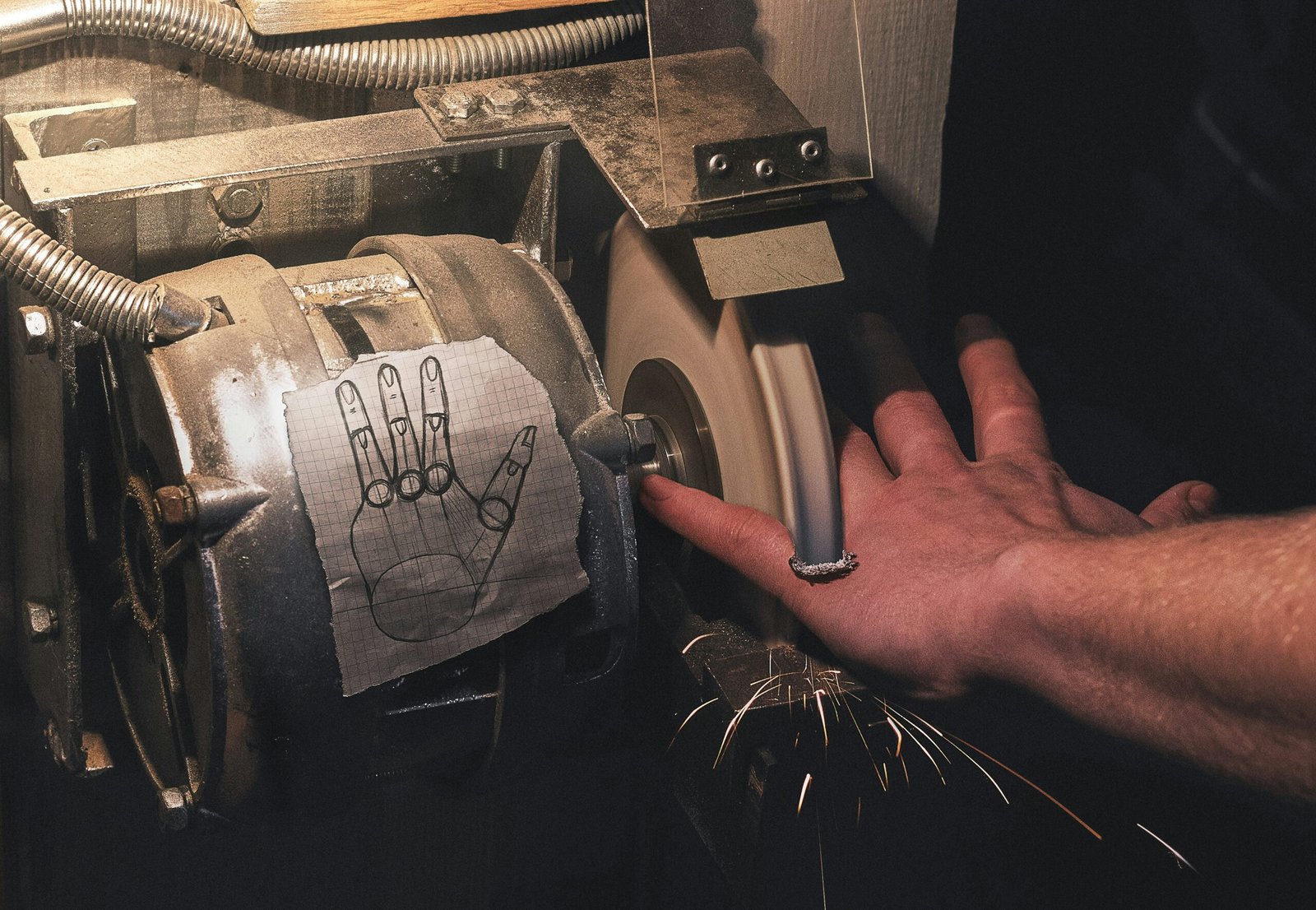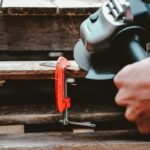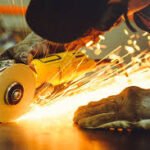Introduction to Angle Grinders and Their Uses
Angle grinders are versatile power tools that play a crucial role in numerous industries, including metalworking, construction, and remodeling. Engineered for cutting, grinding, and polishing, these tools are designed to handle a variety of materials, from metal to masonry. With their rotating discs, angle grinders facilitate efficient work processes, making them indispensable for professionals and DIY enthusiasts alike.
In metalworking, angle grinders are often utilized for removing excess material, ensuring smooth finishes, and sharpening tools. The high-speed rotating discs enable users to perform tasks with precision and efficiency, significantly improving productivity in workshops. In the construction domain, these tools are frequently employed for cutting rebar, tiles, or metal sheets, as well as for surface preparation. For remodelers and homeowners, angle grinders serve as an essential tool for renovation projects, providing the ability to cut through materials with ease.
Moreover, the adaptability of angle grinders allows for the use of various attachments, which further extends their functionality. Different types of grinding wheels and cutting discs can be fitted onto these tools, enabling users to tackle diverse applications. Whether it’s polishing metal surfaces to a brilliant shine or grinding down welds for finishing touches, angle grinders deliver exceptional versatility.
However, despite their many advantages, the use of angle grinders is not without risks. The combination of high-speed rotation and metal to metal contact can lead to serious injuries if safety protocols are not followed. Understanding both the capabilities and the hazards associated with these powerful tools is critical for safe operation. In the subsequent sections, we will delve into these risks and explore effective strategies for injury prevention, ensuring that the benefits of using angle grinders can be enjoyed while minimizing potential dangers.
Common Types of Angle Grinder Injuries
Angle grinders are versatile tools widely used in construction and metalworking. However, they pose significant risks, leading to various injuries if not handled properly. Understanding the common types of injuries associated with angle grinders is essential for ensuring safety on the job site.
One prevalent injury type is cuts, often occurring due to accidental contact with the rotating wheel. These injuries can range from minor lacerations to severe gashes that may require medical attention. According to industry statistics, over 40% of angle grinder injuries involve cuts to the hands and arms, highlighting the necessity for effective personal protective equipment (PPE).
Burns represent another serious risk. They can occur when sparks generated during grinding come into contact with skin or clothing. Additionally, prolonged use of the tool can cause overheating, which can lead to thermal burns, especially if proper cooling breaks are not taken. Statistics indicate that approximately 15% of angle grinder injuries are burn-related, underscoring the importance of wearing heat-resistant gear.
Eye injuries are equally concerning, as flying debris from grinding operations poses a significant threat. Protective eyewear is critical to prevent damage from sparks and metal fragments. Reports show that eye injuries constitute about 30% of angle grinder accidents, reinforcing the need for ocular protection as a standard practice.
In addition to cuts and burns, angle grinders can also contribute to hearing loss due to prolonged exposure to high noise levels. Studies indicate that around 25% of users experience significant hearing damage over time. Respiratory issues may arise if the operator is not equipped with adequate ventilation and respiratory protection, as inhaling metal dust and particles can have long-term health implications. It is evident that injuries stemming from angle grinders can have severe consequences, making awareness and prevention essential.
Understanding the Mechanisms of Injury
Angle grinders are powerful tools widely used in construction, metalworking, and fabrication. However, their improper use can result in serious injuries, primarily due to the mechanics behind their operation. One of the primary mechanisms of injury relates to the rotating discs. When an angle grinder is activated, the disc can rotate at high speeds, typically between 5,000 and 12,000 revolutions per minute. If the disc encounters an object that is not part of the intended operation, such as the user’s body, severe lacerations or amputations can occur.
Another significant risk factor associated with angle grinder use is the generation of sparks and flying debris. These tools typically produce sparks during cutting or grinding operations, especially when working with metal. This flying debris can cause eye injuries, burns, or cuts, particularly if the user is not equipped with appropriate personal protective equipment (PPE). Additionally, any material dust, fragments, or pieces resulting from the operation may rebound and injure the operator or bystanders if not appropriately contained.
Improper handling of the angle grinder is another crucial factor in injury occurrences. Users who lack training or experience may misuse the tool, such as applying excessive pressure, which can lead to a loss of control or kickback. Furthermore, angle grinders may malfunction due to worn or damaged components, such as blades that are not securely fastened. Such malfunctions can increase the risk of the tool breaking apart during operation, resulting in injury from flying parts. Preventing angle grinder injuries involves understanding these mechanisms and recognizing the importance of employing safety protocols and using the appropriate PPE during operations.
Factors Contributing to Angle Grinder Injuries

Angle grinder injuries are often the result of a combination of various factors that increase the likelihood of accidents occurring during their operation. One primary contributor is the lack of adequate training. Many users may not fully understand how to operate an angle grinder safely, leading to errors in handling and increased risk of injury. Comprehensive training programs can help users recognize potential hazards and properly use the tool, significantly reducing the risk of accidents.
Another significant factor is the failure to use personal protective equipment (PPE). Safety glasses, gloves, face shields, and appropriate clothing are essential while operating angle grinders. Neglecting to wear this protective gear exposes users to severe injuries such as cuts, burns, or eye damage from flying debris. Employers and individuals should prioritize PPE to minimize risks associated with angle grinder usage.
Tool misuse is yet another critical factor that contributes to angle grinder injuries. Users may operate the tool for tasks it was not designed for, or they may use improper attachments that could lead to instability or equipment failure. Utilizing the angle grinder as specified in the manufacturer’s instructions is vital to ensure optimal performance and safety. Additionally, routine maintenance is essential; a poorly maintained tool is more likely to malfunction, causing injury.
Finally, workspace hazards play a significant role in angle grinder injuries. Cluttered or poorly lit work areas can create dangerous conditions, increasing the chance of tripping or misjudging the tool’s position. Maintaining a clean and well-organized workspace enhances safety and allows for better visibility, making it easier to identify potential risks before they lead to injuries. By addressing these factors—training, PPE usage, tool misuse, and workspace management—it’s possible to significantly reduce the incidence of angle grinder-related injuries.
The Importance of Personal Protective Equipment (PPE)
Personal Protective Equipment (PPE) is vital in safeguarding individuals from the inherent risks associated with the use of angle grinders. These powerful tools, while immensely useful in various tasks, can cause severe injuries if appropriate safety measures are not adhered to. The right PPE can significantly reduce the likelihood of accidents and injuries by providing barriers against potential hazards, such as flying debris, sparks, loud noises, and inhalation of harmful particles.
One of the essential components of PPE when operating angle grinders is gloves. Specialized cut-resistant gloves are designed to protect hands from abrasions and cuts that can occur during grinding tasks. It is crucial to select gloves that fit properly to ensure dexterity while maintaining protection. Another critical piece of protective gear is safety goggles or face shields. These items are designed to shield the eyes from flying particles, metal shards, and grinding dust, all of which can lead to severe eye injuries. For maximum protection, a combination of safety goggles and face shields should be considered.
Hearing protection is also an essential part of PPE. Angle grinders can produce noise levels that exceed safe hearing limits. Employing earmuffs or earplugs can effectively mitigate the risk of hearing loss that may result from prolonged exposure to high noise levels. Additionally, respiratory masks are necessary when working in environments where fine dust and airborne particles are present. These masks help filter out harmful particles, ensuring cleaner air for the user.
Ultimately, choosing the appropriate PPE and utilizing it correctly plays a pivotal role in injury prevention. Employees and operators must be educated on the types of PPE available, as well as when to use them, to maximize protection while using angle grinders. Through proper PPE selection and adherence to safety protocols, the risk of angle grinder injuries can be significantly reduced.
Best Practices for Safe Use of Angle Grinders
Ensuring the safe use of angle grinders is paramount to prevent injuries in the workplace or home settings. One of the critical factors in promoting safety is proper operator training. All personnel using angle grinders should receive comprehensive training that covers the equipment’s functionality, safety practices, and personal protective equipment (PPE) requirements. This training should not only focus on how to operate the tools effectively but also on recognizing potential hazards and understanding the consequences of improper use.
Regular maintenance of angle grinders plays a significant role in safe operation. This includes routine inspections for wear and tear, ensuring all guards are in place, and confirming that discs are correctly mounted. Any signs of damage or malfunction should prompt immediate repair or replacement. By maintaining equipment in optimal condition, operators can significantly reduce the risk of accidents related to mechanical failures or improper functioning.
Safe work habits are equally essential for reducing the risk of angle grinder injuries. Operators should adopt practices such as maintaining a clear workspace, securing workpieces properly, and ensuring that bystanders are at a safe distance. Using tools in a calm and careful manner helps prevent mistakes caused by distraction. Furthermore, users should always wear the necessary PPE, including safety eyewear, gloves, and hearing protection, to safeguard themselves from flying debris and loud noise.
Lastly, the environment where angle grinders are used should be set up thoughtfully. Operating in a well-ventilated area minimizes the accumulation of dust and vapors, reducing inhalation risks. Keeping the area organized and free of clutter decreases the likelihood of tripping and falling, further enhancing safety during operations. By adhering to these best practices, one can dramatically lower the risks associated with angle grinder usage, contributing to a safer working environment.
What to Do in Case of an Injury
In the event of an angle grinder injury, immediate action is crucial to minimize damage and promote healing. The first step involves assessing the severity of the injury. For minor cuts or abrasions, take a deep breath and remain calm. Begin by cleaning the wound gently with soap and water to remove any debris. After cleansing, apply an antiseptic ointment and cover the area with a sterile bandage to protect it from infection. Additionally, if bleeding occurs, it is essential to apply pressure with a clean cloth or gauze to stop the bleeding.
For more severe injuries, such as deep cuts, lacerations, or burns, seeking medical attention is imperative. Call emergency services if the injury involves significant blood loss, loss of consciousness, or if an object is embedded in the wound. Do not attempt to remove embedded objects, as this may exacerbate bleeding or further damage the tissue. Instead, stabilize the injured area until help arrives.
It is also vital to report workplace injuries to a supervisor or safety officer, regardless of the severity. This step is crucial for maintaining a safe work environment and ensuring that similar incidents do not occur in the future. Documenting the injury can aid in any necessary follow-up treatments and help employers take necessary precautions to enhance safety protocols.
Understanding the immediate steps to take following an angle grinder injury can lead to improved outcomes for the injured individual. By following these guidelines, workers can effectively manage injuries, while simultaneously upholding safety standards within the workplace.
Case Studies: Real-Life Incidents and Lessons Learned
Examining real-life incidents involving angle grinder injuries provides valuable insights into their causes and highlights the importance of safety protocols. One notable case occurred in a manufacturing plant, where a worker sustained severe lacerations when the angle grinder’s guard was improperly adjusted. The worker had been cutting metal, and due to a lack of proper training and equipment checks, the grinder’s disc shattered, resulting in a rapid and dangerous situation. The injuries required extensive medical treatment and recovery time, ultimately leading to changes in safety guidelines within the facility.
Another incident took place at a construction site, where a tradesperson experienced a serious injury when an angle grinder slipped from their grip, resulting in a deep cut to the leg. This incident underscored the significance of using appropriate techniques, such as maintaining a firm hold on the tool while ensuring that the work area was clear of obstruction. Investigators determined that distractions and fatigue contributed to the accident, prompting the need for increased awareness of personal well-being while handling machinery.
In yet another case, an amateur DIY enthusiast suffered eye injuries due to flying debris when using an angle grinder without the proper personal protective equipment (PPE). This incident highlighted the critical need for protective eyewear, as well as proper safety attire to prevent such injuries. The individual learned the hard way that neglecting to utilize basic protective gear can have severe consequences that extend beyond the immediate physical injury.
These case studies reveal a range of factors contributing to angle grinder injuries, including inadequate training, lack of PPE, and environmental distractions. By understanding these real-life incidents, we can better develop safety practices aimed at preventing future injuries, promoting safer work environments, and ensuring that all individuals are equipped with the knowledge needed to operate angle grinders safely and responsibly.
Conclusion: Advocating for Safety in Tool Use
In the discussion surrounding angle grinder injuries, it becomes evident that these accidents can often be traced back to a combination of factors, such as improper usage, lack of safety equipment, and insufficient training. The importance of adhering to safety protocols cannot be overstated; it is crucial for both personal well-being and the broader safety culture within workplaces. Emphasizing comprehensive training and appropriate use of personal protective equipment, such as safety goggles, gloves, and noise-cancelling headphones, is essential to mitigate risks associated with angle grinder operations.
Furthermore, it is imperative that employers cultivate an environment that prioritizes safety and acknowledges the potential hazards of tool usage. This can be achieved through regular safety audits, the implementation of detailed safety guidelines, and fostering open lines of communication regarding workplace safety. When workers understand the risks associated with angle grinders, they are better equipped to take proactive steps to protect themselves and their colleagues.
Engaging in safety advocacy is not just the responsibility of employers; workers also play a vital role. They should feel empowered to voice concerns about unsafe practices and to advocate for improvements in safety protocols. By fostering a culture of safety awareness, employees contribute to a collective effort that enhances the overall safety of the workplace. It is within this shared commitment that we can significantly reduce the incidence of angle grinder injuries.
In conclusion, a united front in advocating for safety in tool use is essential to preventing injuries related to angle grinders. By committing to safety education, proper tool operation, and comprehensive protective measures, both employers and workers can work together to create a safer working environment and significantly reduce the risk of accidents.

